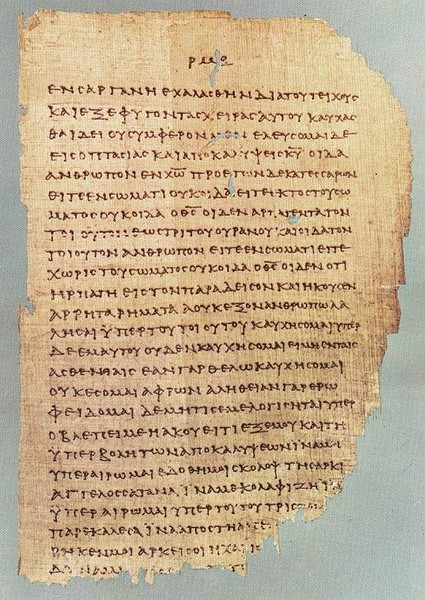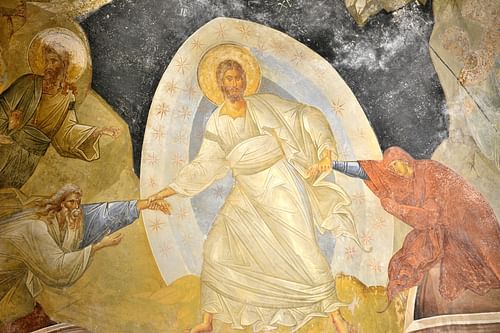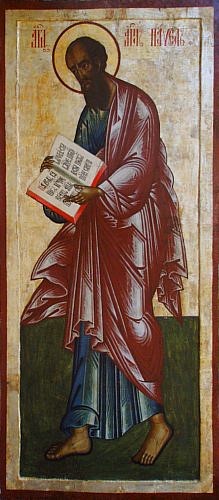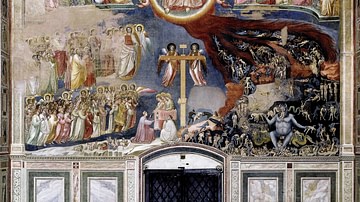Paul was a member of the Jewish Pharisees in the 1st century CE, who experienced a revelation of the resurrected Jesus Christ. In this vision, Jesus commissioned him to be the apostle (herald) to the Gentiles (non-Jews). After this experience, he traveled widely throughout the Roman Empire, spreading the "good news" that Jesus would soon return from heaven and usher in the kingdom of God on earth.

In the New Testament, we have 14 letters traditionally assigned to Paul, but the scholarly consensus now recognizes that of the 14, seven were written by Paul:
- 1 Thessalonians
- Galatians
- Philemon
- Philippians
- 1 & 2 Corinthians
- Romans
2 Thessalonians, Ephesians, and Colossians remain debatable among some scholars. The other major letters (1 &2 Timothy and Titus) were most likely written by disciples of Paul’s, using his name to carry authority. The letters that have survived range between 52 and 60 CE, and although we cannot pinpoint when Paul’s letters were collected, Clement, a bishop in Rome in the 90s CE, quoted from 1 Corinthians.
The Nature of the Letters
We understand these letters to be circumstantial. They were not written as systematic theology or as treatises on Christianity. The letters are responses to specific problems and circumstances as they arose in his communities. Paul spent time in cities establishing a group and then moved on. He received letters and sometimes reports with detailed questions or advice on how to settle conflicts. Unfortunately, when Paul’s letters were saved and circulated, the original letters from the communities were not preserved. The reconstruction of the original problems can only be determined by Paul’s responses.
Known as the most famous convert in history (from the Acts of the Apostles), Paul did not actually undergo conversion. Conversion assumes changing from one religious system to another, but at the time, there was no Christian system for him to convert to. Paul himself was ambiguous when it came to his self-identity:
To the Jews I became like a Jew... To those under the law I became like one under the law (though I myself am not under the law) ... To those not having the law I became like one not having the law (though I am not free from God’s law but am under Christ’s law) ... I have become all things to all people. (1 Corinthians 9:20-22)
In relation to what happened to Paul, it is better to follow what he says, in that he was 'called'. This is the tradition of the way in which the Prophets of Israel were called to their individual missions.
I want you to know, brothers and sisters, that the gospel I preached is not of human origin. I did not receive it from any man, nor was I taught it; rather, I received it by revelation from Jesus Christ. (Galatians 1:11-12).
Paul argued that this experience gave him as much authority as the original circle in Jerusalem (Peter, James, and John). Paul’s call to be the Apostle to the Gentiles was shocking because, as he freely admitted, he had previously "persecuted the church of God" (Galatians 1:13). He never really explained what he did, nor why he did it. It is in Paul’s letters that the name Jesus is combined with Christ, the Greek for the Hebrew messiah ("anointed one"). Understood as a title, "Jesus the Christ", it became common as a phrase that indicated his identity and function.
The Admission of Gentiles
Both the Acts of the Apostles and Paul’s letter to the Galatians describe a meeting held in Jerusalem to resolve an unexpected occurrence. When missionaries took the teachings of Jesus of Nazareth to other cities, they found that Gentiles wanted to join. 'Gentiles' is the broad term for anyone who was not Jewish. Many non-Jews often participated in the synagogues in the cities, as they admired Jewish teachings and ethics. Known as "God-fearers" in the Acts of the Apostles (those who respected the God of Israel), they would have been familiar with the scriptural allusions in the teachings of the followers of Jesus.
The leaders had to decide if these non-Jews could join the movement without becoming Jews first. Judaism had unique identity markers: circumcision, dietary laws, and Sabbath observance from the Law of Moses. At the meeting, it was decided that these people did not have to undergo circumcision, nor the other identity issues, but did have to abstain from the things "polluted by idols" (Acts 15:20), and avoid any meat from an animal strangled or killed in the wild. They also had to cease their "sexual immorality" which may be a reference to following Jewish incest laws and not the ones of the dominant culture. Paul felt vindicated by this decision because that is what he had been teaching in his communities for years.
Although a decision was made in Jerusalem, apparently the issue of Gentile inclusion continued to be debated in the communities. This problem is found in all of Paul’s letters. In Galatians, Paul opens the letter by complaining that after he left the region, false apostles came and taught "a different gospel" (Galatians 1:6). In other words, some members continued to insist that Gentiles become Jews first. Paul’s arguments for the inclusion of Gentiles without becoming Jews included polemic against the false apostles which could be quite stringent at times. This led to a misconception that Paul taught against his former religion in light of the new one.
But in relation to ethnic identity, the Law of Moses was only directed to Jews; Gentiles were never expected to adopt Jewish identity markers. The Prophets of Israel all predicted that in the final days, some Gentiles would turn and worship the God of Israel. They would become part of Israel but retain their ethnic identity as Gentiles. Everything Paul wrote about Judaism and the Gentiles was related to this. The turning of the Gentiles convinced Paul that what the Prophets had foretold was manifest in the communities of believers.
Paul’s Eschatology & Ordeals
When reading Paul’s letters, it is important to remember that in the context of Paul’s missions, he worked within a limited timeframe. Jesus had taught the imminence of the kingdom of God roughly 20 years before. For Paul, it was still to be manifest, although "the time is short" (1 Corinthians 7:29). Paul was not establishing a new religion; he believed that his generation was the last before the end time when the universe would be transformed and all social conventions would be changed. Paul adopted an early Christian claim known as the parousia ("second appearance") that Christ would return to earth and complete the end-time prophecies. Paul saw himself and his fellow believers as the last generation of the old order.
From Paul’s letters, we understand that when Paul entered a city he began attracting followers, either from synagogue communities or the forum. Although all English Bibles translate these communities as "churches", there were no church buildings for approximately 300 years. "Church" is translated from the Greek ecclesia and meant "assembly". Cities of the empire had assemblies of local citizens who made up the government in the form of elected magistrates, and Paul apparently applied this model. His followers met in individual houses, and he mentions many of the people who opened their houses for meetings in his letters.
In 2 Corinthians, Paul complained about not getting the same respect as the other apostles:
Are they servants of Christ? (I am out of my mind to talk like this.) I am more. I have worked much harder, been in prison more frequently, been flogged more severely, and been exposed to death again and again. Five times I received from the Jews the forty lashes minus one. Three times I was beaten with rods, once I was pelted with stones, three times I was shipwrecked, I spent a night and a day in the open sea... (2 Cor. 11:23-25).
Lashes were part of synagogue punishments for violations of Mosaic Law. Paul never provided details on this. Rods were a Roman punishment for civil disorder. Paul referred to his constant sufferings throughout his letters to validate how much he had labored for the benefit of believers.
Galatians
In this letter, Paul introduced what became one of his most famous teachings: "a person is not justified by the works of the law, but by faith in Jesus Christ" (Galatians 2:16) English Bibles translate the Greek pistis as "faith" but it meant "loyalty". In this sense, loyalty to the teachings of Christ as transmitted through Paul. (This is where Martin Luther obtained his concept of faith alone leading to salvation.) However, what Paul meant was that Gentiles are admitted without "the works of the Law" referring to those physical barriers that kept Jews and Gentiles apart.
In his letters, Paul consistently tried to eliminate social and cultural barriers in the group. Once admitted, Gentiles had to follow the precepts of the Mosaic Law. As a Pharisee, the Law of Moses held great meaning for him, and he repeatedly applied quotations from the Law of Moses in relation to ethics and behavior. He could never say that the Law was not good, but when it came to the Gentiles, the physical rituals of Moses were not required. In Galatians, Paul wrote that God gave the Law as a pedagogus (a tutor, a guide), to define sin. Without the Law, we could not know right from wrong. But now, Christ had come as the teleos (end or goal) of the Law.
"Justified" was one of those Greek words that had several meanings. In English Bibles, it is sometimes translated as "justified" and sometimes as "righteoused", to be declared "righteous". Paul’s concept was more fully explained in his letter to the Romans. He presented the death of Jesus as an atonement for the sin of Adam. Adam’s sin resulted in the punishment of human death, and Christ’s death resulted in eternal life (resurrection). Believers were acquitted (justified) of this punishment; Paul believed his generation would literally not suffer physical death. The later Church retained the concept of parousia, but now at a future date. Christians would still physically die but had the opportunity for eternal life in heaven.
1 Thessalonians
One of the earliest of Paul’s letters, the community at Thessalonica had written to him in some distress. Members of the community had died before the return of Christ. Paul wrote back:
According to the Lord’s word, we tell you that we who are still alive, who are left until the coming of the Lord, will certainly not precede those who have fallen asleep. For the Lord himself will come down from heaven, with a loud command, with the voice of the archangel and with the trumpet call of God, and the dead in Christ will rise first. After that, we who are still alive and are left will be caught up together with them in the clouds to meet the Lord in the air. And so we will be with the Lord forever. Therefore encourage one another with these words. (1 Thessalonians 4:15-18)
This passage was later adopted by Christian believers in the 17th century to posit the concept known as "the rapture" or the taking of good Christians to heaven before the violence of the final days began as described in the Book of Revelation.

Philippians
Paul presented a confusing combination about Jesus: Jesus was both a divine pre-existent figure present at the creation and "a descendant of David ... who through the Spirit of holiness was appointed the Son of God in power by his resurrection from the dead" (Romans 1:3). An early hymn recited by Paul is found in Philippians 2:6-11:
[Jesus] Who, being in the very nature God, did not consider equality with God something to be used to his own advantage; rather, he made himself nothing by taking the very nature of a servant, being made in human likeness. And being found in appearance as a man, he humbled himself by becoming obedient to death—even death on a cross! Therefore, God also highly exalted him and gave him the name that is above every name, so that at the name of Jesus every knee should bend, in heaven and on earth and under the earth, and every tongue should confess that Jesus Christ is Lord, to the glory of God the father.
"... and gave him the name that is above every name" is the Tetragrammaton (YHWH), the name of God. That "every knee should bend" meant worship in an age-old concept of bowing down before images of various gods. Philippians 2:6-11 is essentially an exegesis (interpretation) of Isaiah 45-53, known as the "suffering servant" passages. The suffering servant humbled himself in obedience, suffered, and died, only to be resurrected and exalted above all others and placed beside God on the heavenly throne. Some Jews had interpreted the passage in Isaiah to mean that God had manifested himself in this servant. That God was literally present in Jesus was later canonized in the concept of the trinity, with the First Council of Nicaea in 325 CE declaring that God and Jesus were of identical essence.
Christian believers worshipping Jesus as God and Paul’s demand that Gentiles cease idolatry most likely caused problems, which led to his ordeals in the synagogues as well as in the forums.
1 & 2 Corinthians
The Corinthian correspondence is a fascinating window on one of the earliest Christian communities. After Paul left the city, he had reports that the Corinthians had misunderstood many of his teachings. Throughout 1 Corinthians, he admonished the community for establishing factions or splinter groups. They were divided over who was better for having been baptized by either Paul, Apollos (a Christian from Alexandria), or Peter. They were suing each other in the public law courts and were confused over whether widows should remarry. They were also in competition over who had the best "gifts of the spirit" (speaking in tongues, prophecy, healing), and the remembrance of the Lord’s supper had become reduced to fighting over food and drink. Some members had also begun teaching against the concept of the resurrection of the dead.
As Paul addressed all these problems, the letter contains what would become some of the most spiritual, enlightening elements of Christian teaching. 1 Corinthians 13 contains Paul’s lecture on the true meaning of love for each other in the community. 1 Corinthians 15 is the only place in the New Testament that described what resurrection will be like, as believers are transformed into spiritual bodies to welcome the returning Christ.
2 Corinthians is an esoteric, self-reflection on Paul’s experience of having an out-of-the-body journey to the heavens to be shown secrets of the final days. This letter incorporates philosophical views and has led many to utilize it in analyses of the mystical Paul.
Romans
This letter is one of his most complete as he was introducing himself to the Romans and simultaneously explaining his teachings. Many of the issues from the other letters are repeated and more fully worked out in this final missive that encapsulates Pauline theology. In Romans 7 he reflected on why humans sin. In a complicated passage, he claimed that despite the Law (knowing right from wrong), we sin because the power of sin is an active force within us. Christ’s death and resurrection (taking on the power of sin), released those from this power who have faith in Christ.

In Romans, we find one of the few times that he addressed his fellow Jews:
I have great sorrow and unceasing anguish in my heart. For I could wish that I myself were cursed and cut off from Christ for the sake of my people, those of my own race, the people of Israel. Theirs is the adoption to sonship; theirs the divine glory, the covenants, the receiving of the law, the temple worship and the promises. (Romans 9:2-4).
Once the Jews saw what has happened to the Gentiles, they will ultimately repent and accept the good news of Christ and believe. In the meantime, the Gentiles are not to gloat over their good fortune, as they are secondary.
I do not want you to be ignorant of this mystery, brothers and sisters, so that you may not be conceited: Israel has experienced a hardening in part until the full number of the Gentiles has come in, and in this way all Israel will be saved. (Romans 11:25-26)
Paul did not indicate a timeframe nor any idea of a quota, but this was Paul’s self-understanding of his role in salvation: the kingdom awaited Paul’s crucial work among the Gentiles and then the Jews would come to believe.
In terms of influence and numbers, we have no definite figures for how many people Paul helped to become the new believers. But in the middle of the 2nd century, Paul’s teaching became the basis of Christian dogma. In quoting Paul, they consistently referred to him as "the Apostle", a title he would have been proud of.










